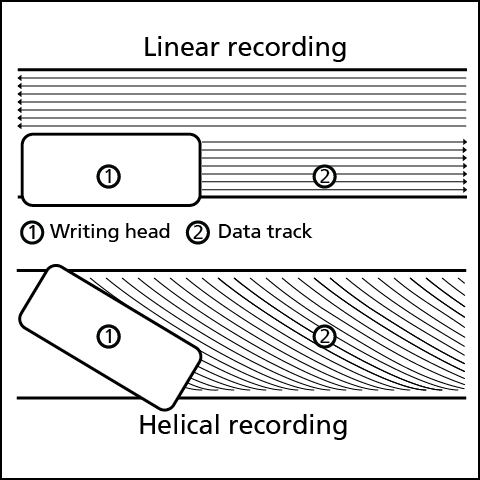A crucial component of writing a magnetic tape is the writing head. He´s composed of a magnetic conductible core and an inductor with 6 to 7 coils. When responding current flows through the inductor a magnetic field emerges. This field leaks through a vent on the side of the magnet and affects the magnetic tape [5]. Thus the orientation of the pigments is changed. Hereby information can be encoded binary in the tape. The data stay secured as long as the needles don’t change their orientation again. The tape possesses several tracks. Information is typically stored in blocks with a size of 2048Byte. The bits of a byte are put on 7 or 9 tracks one above the other [10]. The last track serves for control purposes. Thereby a parity bit is put, if there is an even number of ones in the column. In addition a horizontal parity bit and test mark are added into the end of each code-block. In this way particular incorrect bits can be fixed [9]. Due to the fact that there is a reading head behind the writing head, immediately check of the saved block is possible. The writing happens strict sequential. For writing and reading it´s important, that the tape is moving with a constant speed. Because of that you can´t read while you are fast-forwarding a tape [10].

You can differentiate in 2 methods of writing: The linear recording and the helical recording (also called “helical scan”). In the case of linear recording you write serpentine-line-shaped on several of up to 488 horizontal arranged tracks simultaneously. Furthermore it is saved in both movement directions, which causes a reduction of wind-time. On the other side, the helical scan has the advantage, that the surface of the tape is exploited effectively, since the tracks are written more closely next to each other. This happens because of a slightly inclined writing head, which results millions of short tracks. The disadvantage of this method is the need of much higher precision. Only minimal inaccuracies of the inclination angle or position of the tape effect, that a tape, which is written in a curtain device, cannot be read in another [8]. At reading, areas of pigments, that have the same orientation, induces voltage into the coils of the magnetic head. Then the voltage is transformed in a binary signal. The memory capacity of a magnetic tape is determined by his length, the quantity of the written tracks and the recording density.